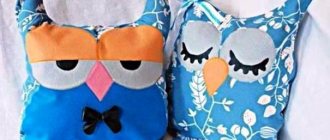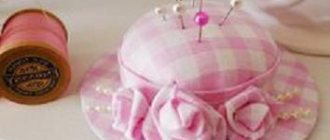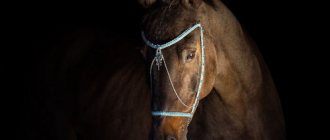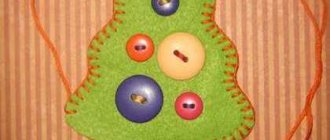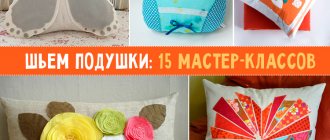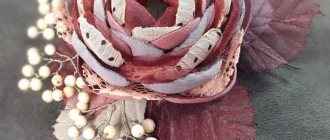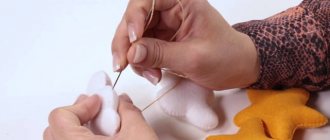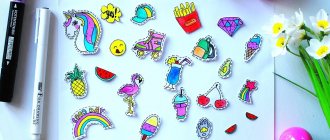In order for a child to have good health, he needs daily walks, even when it is snowing outside and the cold wind is blowing. There are a great variety of insulated envelopes, footmuffs, etc. for kids. But the mother is also outside with the child and her hands, which are constantly on the handle of the stroller, are especially not protected from the weather. Especially for such cases, a warm fur muff is suitable, which will protect your hands from bad weather and keep them warm. In this article we will talk about how to sew a muff for a stroller quickly and easily with your own hands.
We sew a beautiful and warm muff for a stroller with our own hands
1) Needle, scissors, ruler, sewing machine;
2) Raincoat fabric – ? m.;
3) Faux or natural fur, can you make fleece – ? m.;e
4) Internal insulation – ? m. It is especially important to fill the muff with insulation if faux fur is used - its knitted base perfectly allows cold air to pass through and your hands will freeze. You can use batting or padding polyester. In the first case, the insulation is sewn between a layer of bolognese and fur fabric, but in the second case, the insulation is stuffed inside through the allowance in the seam. The thickness of the insulation can also vary depending on what kind of lining is used: if it is natural fur, you can make it very small; if it is fleece or faux fur, then you need to better insulate the muff;
5) Buttons for clothes (you can’t install them manually - you’ll have to visit the nearest hardware department and do it there) or sets of buttons with punches. Their advantage is that they can be installed at home with a hammer, but they are not so easy to find in the store. It is better to purchase any buttons with a long stem - the width of the coupling will be rather large;
6) Various devices for decoration (can be decorated with rhinestones, beads, fur scraps, etc.)
How to make patterns for a coupling?
In this case, you do not need to draw everything separately on paper and cut it out. You can immediately mark the desired lines on the fabric.
The first thing you need to do is decide on the size. The optimal rectangle is 47x52 cm. It must be drawn on the wrong side of the bolognese fabric.
After the rectangle has been marked, a median line is drawn along the sides of the rectangle (from a side of 47 cm). On this median line, 12x4 cm notches are marked.
This will be the pattern, which is then transferred to the fur fabric.
We sew and fill the sleeve.
Now it’s time to cut out the pattern from bolognese fabric. You need to cut carefully, rounding the corners.
Then, by attaching the pattern to the fur fabric, you can make a fur blank. You need to cut strictly along the base of the fur so as not to damage the fibers. The edges of the fur blank should be smooth, not torn.
From the remaining scraps of fur you can cut out circles and make pompoms (the diameter depends on how much fabric is left and what size pompons are needed).
By placing fur and bolognese fabric next to each other, the product is swept away. Leaving a small allowance (about 15 cm), the coupling is sewn on a sewing machine. Through the resulting hole you can turn the product inside out. Now it can be filled with padding polyester or other insulation.
If fur and padding polyester fibers suddenly stick to the raincoat fabric, this can be easily removed with a damp cloth.
The allowance must be carefully sewn by hand. On the wrong side, the location of the buttons is marked, and the middle line is sewn. You can also stitch decorative patterns, for example, like this:
Now all that remains is to take the coupling to the accessories department and attach the buttons and decorate as desired.
Pompoms for the muff.
You can make pompoms from leftover fabric - take a circle and sew stitches measuring 5 mm. along its edge. Place a piece of filling inside and pull off the pompom. Attach a lace or satin ribbon to it and sew it to the muff.
You can decorate the muff with rhinestones, various beads, and make personalized embroidery.
Pocket on the coupling.
For convenience, you can make a pocket on the muff, in which you can put a phone, wallet or some other small item. To do this, you need to cut out two identical pieces of pocket and valve from raincoat fabric.
First, the flap is basted and stitched, and then the pocket itself. While the parts are not sewn to the coupling, it is necessary to sew Velcro on them with the hard side facing the pocket. And soft to the valve.
The finished pocket can be stitched to the coupling. If desired, it can be divided into two or three sections, if length allows. This can be done simply by sewing a pre-designated line on the pocket.
The valve is attached last and the pocket on the coupling is ready.
The cold season is coming. This means it’s time to thoroughly insulate yourself. And our hands need it too. Mothers with strollers will understand me. In winter, especially in windy weather, when pushing a sled or stroller, our hands freeze, despite the fact that we wear gloves. Here an interesting invention comes to our aid - muffs! This thing will warm your hands and protect you from the wind. It is very convenient to use, because it is attached to the handle of the “children’s transport” using buttons or Velcro. So, you won’t have to hold it, take it off, or put it on again and again. To keep your hands always warm, let’s sew together a muff onto the handle of a stroller (or sled). This item will not only warm your hands, but will also serve as a stylish decoration.
two types of muffs - a large one-piece muff for both hands or a pair of small muffs-mittens.
I present to your attention two master classes on how to sew with your own hands two types of a very necessary thing in winter - muffs for the handle of a stroller. In such muffs, mother's hands will always be warm. And sewing them couldn’t be easier. In addition to unique author's photographs, the author's coupling patterns are included.
One-piece hand muff for stroller
For work we will need: - fabric - raincoat fabric 0.5 m; — insulation – synthetic winterizer 0.5 m; - lining - fleece 0.5 m.
Pattern of a one-piece muff for both hands
We sew a one-piece hand muff for the stroller
Using the included pattern, cut out the fabric pieces. One piece from raincoat fabric, one piece from synthetic padding and one piece from fleece. Cut the fleece piece in half.
I have a combined upper part - made of fabrics of two colors. You can also experiment with the pattern and cut it to your liking. Sew together the details of the raincoat fabric. To make the machine sew easier, place paper or newspaper underneath. If your top is one color, skip this step.
That's how it happened.
We connect all three parts of the future coupling. First, we connect the fleece and the raincoat fabric face to face, then we apply padding polyester to the wrong side of the raincoat fabric. We chop everything off with needles and stitch around the perimeter on a sewing machine.
We cut off the corners and make notches in the circles. Turn right side out through the slit in the fleece piece.
Now you need to sew on the Velcro. Cut off the required amount. Approximately 10 cm on both sides.
Sew it on. We pull the threads to the wrong side, tie and cut.
Please note that we sew one side of the Velcro from the front side, and the other side from the inside.
This is how it should turn out.
Our fleece is cut in the middle, remember? We sew this place with a hidden seam.
All that remains is to sew the Velcro in the center of the coupling. We determine the middle, draw a line and, guided by the line, sew on about 5 cm of Velcro.
The coupling is ready!
This is what the clutch on the handle of the sled looks like.
Just a couple of hours of work and an excellent result is in front of us. Now your sled and stroller will be complemented with a stylish accessory, and your hands will not be afraid of either wind or frost. Try decorating your muff with rhinestones or embroidery, adding contrasting details and create your own unique masterpiece. If you have a stroller with two handles, then you can sew a muff like this .
You can also add another very necessary item to the clutch kit - a stroller bag. Master class here . Success in creative work!
Separate muffs
I didn't really like the first option. Hands are limited to the space of the coupling. That is, you always have to keep your hands in the center of the stroller handle. So I decided to sew separate couplings. They turned out to be much more convenient than the first option. I can place my hands either in the middle of the handle or on the sides. I can change the position of my hands at any time. Another “plus” of such a coupling is that it is universal. It can also be used on a cane stroller with separate handles.
To work we will need:
— raincoat fabric for the top of the muff 50x55cm; — fleece or velsoft for the inside 50x55cm; — padding polyester for insulation inside 50x55cm; — Velcro about 45 cm.
Muff-mitten pattern
The pattern is given with seam allowances. We will cut out the details according to it.
We sew muffs-mittens for the stroller
It is necessary to cut out 2 parts from padding polyester, 2 parts from fleece (and cut in half) and 2 parts from raincoat fabric. I decided to combine two colors. Therefore, I use a pattern cut in half and cut out two halves from green raincoat fabric and two from gray.
We grind down the raincoat fabric parts. If you are sewing from one color, then cut out the whole part and skip this step.
Putting all the details together.
You should end up with a “sandwich” like this: a raincoat fabric with fleece folded face to face, and padding polyester on top. Remember that the fleece needs to be cut in half. This is necessary for subsequent turning.
We grind along the entire perimeter of the part. It is best to sew on raincoat fabric.
Cut off excess seam allowances.
Now you need to make a hole in the padding polyester for turning it inside out. Turn it right side out.
This is what we got.
We sew Velcro to the places shown on the pattern.
We sew the hole in the middle with hidden stitches by hand.
That's all, the muffs are ready. Can be used on a stroller.
Now your hands are not afraid of wind and frost, they are securely hidden.
Enjoy your walks in the fresh air!
Author of the material: Fount
To make the coupling we need:
raincoat fabric 55x55 cm, padding polyester, faux fur, buttons, threads in the color of the raincoat fabric, scissors, tailor's pins.
1. Transfer the pattern to the wrong side of the raincoat fabric and cut out the part. Folding it in half, trace it on the fur, cut out 2 halves of the part (with an allowance of 1 cm along the inner cut).
2. Fold the fur halves with the right sides inward and sew along the middle cut, leaving an opening for turning 10-12 cm wide.
3. Place a piece of raincoat fabric on the padding polyester with the right side up and pin it with tailor’s pins (photo 1).
4. We lay a zigzag stitch along the entire perimeter of the raincoat fabric. This securely fixes the insulation and simplifies further work on the coupling. Carefully cut off the excess padding polyester at the edges (photo 2) Place a straight machine stitch in the middle of the resulting workpiece (photo 3)
5. We fold the parts made of fur and raincoat fabric with padding polyester with the right sides inward and pin them together (photo 4). We grind them along the perimeter of the coupling. If necessary, cut off the corners of the allowances and turn the product inside out through the hole in the fur part (with the raincoat facing out). We straighten the corners with scissors.
6. Hand sew up the turning hole. We install buttons in the product (photo 5). With their help, we fix the coupling by bending it around the handle of the stroller. It's time for a walk!
Warming accessory
The prototype of the first muffs were elongated sleeves with fur cuffs. They were worn by both women and men, and were sewn from a variety of materials and intricately decorated. An undeservedly forgotten wardrobe detail at the beginning of the last century became a big fashion item as a purely female accessory. In cold Russia, muffs were made mainly from fur.
Gradually, the fashion for these things has passed, but sometimes they can be seen at modern clothing shows or in children's wardrobes. But, as it turns out, modern parents find it very convenient to use muffs for walking with a stroller.
You need to walk with your child in any weather, even in frost and wind, because the baby needs fresh air. And during this period, both children and parents need to be thoroughly insulated. Of course, on a cold day, the baby is always carefully wrapped and covered, but dads and moms sometimes have to freeze. The hands holding the stroller especially suffer in the cold and the piercing wind.
Manufacturers of children's transport have come up with special accessories for this - insulating mittens and muffs for the stroller. They are cylindrical in shape, have holes for hands, and are attached to the stroller handle with buttons or clips. This warm accessory can also perform additional functions:
- can be used on a walk as a small blanket or pillow;
- in some situations, use as a changing mat;
- Place it in a sled, on a swing or on a bench.
This is interesting: Pattern Shirt and shorts for teenagers (р 146/ 152/ 158/ 164)
Test Drive
We attach one edge of the coupling with Velcro to the handle of the stroller. Then we bend one part of the coupling over the handle and connect it to the other using Velcro or buttons. And finally, a few comments that arose after the first use of the product.
- Buttons are still more reliable, since Velcro constantly strives to come loose. The advantage of Velcro is that in an emergency (if you take into account our slippery paths and my “luck”) you can easily free your hand.
- I was used to driving the stroller with my arms spread wide, and therefore the clutch seemed a bit narrow to me. Although I adopted the sewing principle and dimensions from the “factory” product. It might be worth trying to cut the pieces in the shape of a trapezoid, which will expand from the handle to the openings for the hands. In any case, I advise you to focus on the “terrain” when sewing.
- When sewing, do not leave too much distance from the “sticky” edge for the handle. It is necessary that the coupling fits tightly to it, and it is comfortable for your hands to hold on. For the same reason, you should not sew a muff from more than two layers if one layer is quite dense (such as faux fur).
Despite all the comments, “walking” in the muff is really comfortable and warm. At a temperature of minus 20, your hands do not freeze at all, but for greater insulation you can wear gloves.
Pattern for a stroller: find it on the Internet
Every mother wants her child's stroller to be different from others. That's why parents spend so much time choosing a children's vehicle before purchasing. Individuality, brightness and comfort are what their attention is primarily paid to.
Today in stores you can find unusual multifunctional strollers with truly original designs. But the appearance of the products, as a rule, is made in the same tone; most often it is a single-color design without bright prints or inclusions.
The least expensive option to stand out from others is to sew a set into a stroller.
The most resourceful mothers are able to solve this issue. Pattern skills, fabrics and sewing supplies come to the rescue. And it’s worth saying that the tradition of sewing our own original products was passed down to us from our parents and grandparents.
After all, at their age they created, for example, a pattern for an envelope for a stroller with their own hands, and then passed it on to their friends, and they, in turn, passed it on to other friends. Then the main problem was the question: where to find the pattern? After all, often not everyone was willing to share the work of their work, or the necessary acquaintances might not have been there.
Here we had to resort to a variety of tricks: search in purchased magazines, visit libraries, ask people, go to studios and even buy for money.
Nowadays, finding a pattern “How to sew a stroller with your own hands” has become much easier, because there is a worldwide Internet.
Here, many people are quite willing to share the necessary drawings, provide detailed descriptions of the process and post video instructions.
Especially for our readers, we studied the question of how information is presented on the Internet on the topic “Ways to alter a baby stroller.” And we will share our opinion with you.
